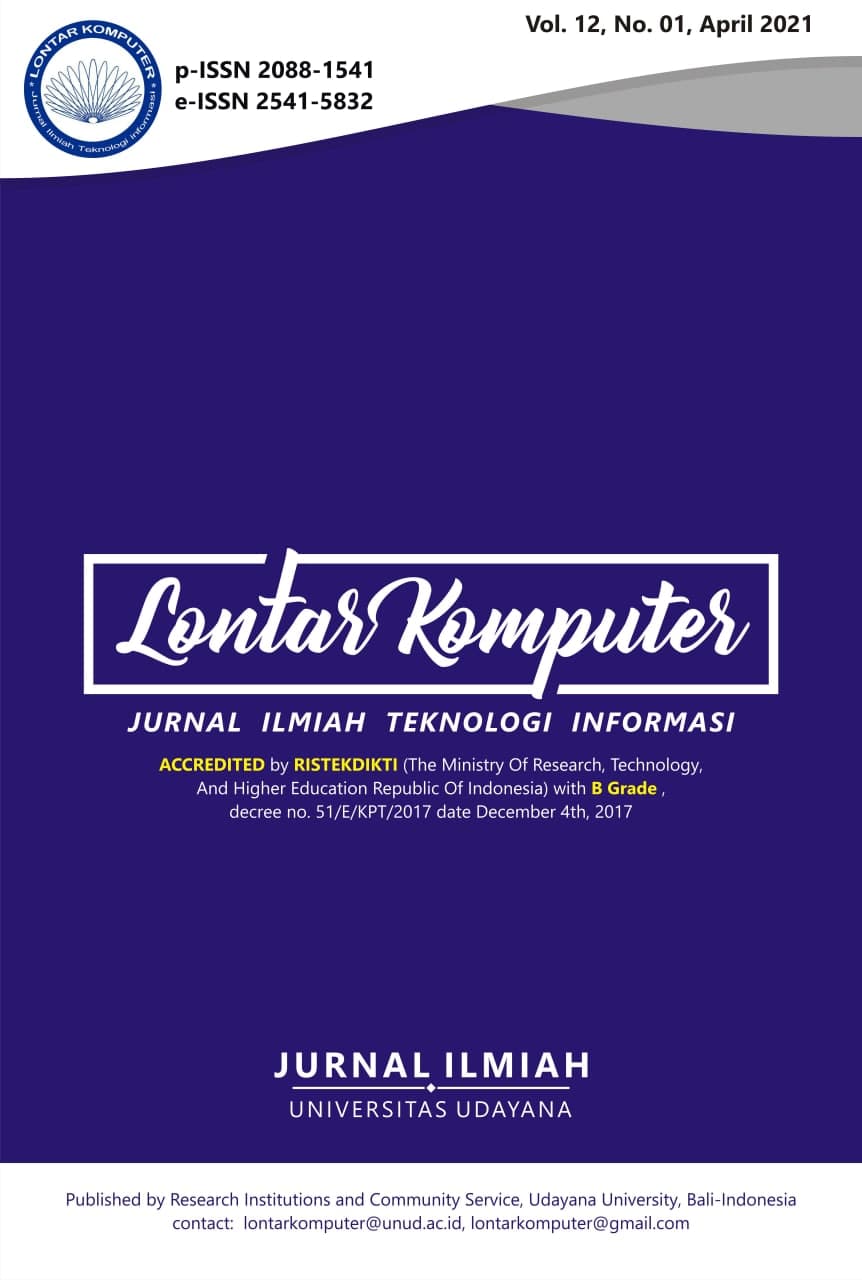Recognition of The Baby Footprint Characteristics Using Wavelet Method and K-Nearest Neighbor (K-NN)
Abstract
Individual recognition using biometric technology can be utilized in creating security systems that are important in modern life. The individuals recognition in hospitals generally done by conventional system so it makes more time in taking identity. A newborn baby will proceed an identity tagging after birth process is complete. This identity using a bracelet filled with names and ink stamps on paper that will be prone to damage or crime. The solution is to store the baby's identity data digitally and carry out the baby's identification process. This system can increase safety and efficiency in storing a baby's footprint image. The implementation of baby's footprint image identification starting from the acquisition of baby's footprint image, preprocessing such as selecting ROI size baby's footprint object, feature extraction using wavelet method and classification process using K-Nearest Neighbor (K-NN) method because this method has been widely used in several studies of biometric identification systems. The test data came from 30 classes with 180 images test right and left baby's footprint. The identification results using 200x500 size ROI with level 4 wavelet decomposition get recognition results with an accuracy of 99.30%, 90.17% precision, and 89.44% recall with a test computation time of 8.0370 seconds.
Downloads
References
[2] M. Manjunath, "Biorthognal, Symlet & Discrete Meyer Wavelet Based Palm Print Recognition System," Perspectives in Communication, Embedded-Systems Signal-Processing, Vol. 2, No. 7, Pp. 319–323, 2018.
[3] N. L. W. S. R. Ginantra, “Deteksi Batik Parang Menggunakan Fitur Co-Occurence Matrix Dan Geometric Moment Invariant Dengan Klasifikasi Knn,” Lontar Komputer Jurnal Ilmiah Teknologi Informasi, Vol. 7, No. 1, P. 40, 2016, Doi: 10.24843/Lkjiti.2016.V07.I01.P05.
[4] Armanda Nur Fadhlillah, “Analisis Dan Implementasi Klasifikasi K-Nearest Neighbor (K-Nn) Pada Sistem Identifikasi Biometrik Telapak Kaki Manusia,” Telkom University Collection, Vol. 2, No. 2, Pp. 2876–2883, 2015.
[5] Y. N. F. Adinda Maulida, Rita Magdalena, “Implementasi Metode Discrete Wavelet Transform (DWT) Dalam Sistem Identifikasi Telapak Kaki Manusia dengan Klasifikasi Support Vector Machine (SVM),” Prosiding Seminar Nasional Aplikasi Sains & Teknologi (SNAST) 2018, No. September, 2018.
[6] Novar Setiawan And I. M. Suwija Putra, “Klasifikasi Citra Mammogram Menggunakan Metode K-Means, Glcm, Dan Support Vector Machine (Svm),” Jurnal Ilmiah Merpati (Menara Penelitian Akadademik Teknologi Informasi), Vol. 6, No. 1, P. 13, 2018, Doi: 10.24843/Jim.2018.V06.I01.P02.
[7] M. Melina, Dr.Ir.Bambang Hidayat, Suci Auliya, St., “Pengklasifikasian Tinggi Dan Berat Badan Manusia Berdasarkan Citra Telapak Kaki Menggunakan Metode Discrete Wavelet Transform (Dwt) Dan Support Vector Machine-Multiclass (Svm-Mc),” Telkom University, Vol. 5, No. 3, Pp. 5245–5257, 2018.
[8] I. G. A. Socrates, A. L. Akbar, M. S. Akbar, A. Z. Arifin, And D. Herumurti, “Optimasi Naive Bayes Dengan Pemilihan Fitur Dan Pembobotan Gain Ratio,” Lontar Komputer Journal Ilmiah Teknologi Informasi, Vol. 7, No. 1, P. 22, 2016, Doi: 10.24843/Lkjiti.2016.V07.I01.P03.
[9] F. Muwardi And A. Fadlil, “Sistem Pengenalan Bunga Berbasis Pengolahan Citra Dan Pengklasifikasi Jarak,” Jurnal Ilmiah Teknik Elektro Komputer Dan Informatika, Vol. 3, No. 2, P. 124, 2018, Doi: 10.26555/Jiteki.V3i2.7470.
[10] M. A. R. Muhammad Rafi Farhan, Agus Wahyu Widodo, “Ekstraksi Ciri Pada Klasifikasi Tipe Kulit Wajah Menggunakan Metode Haar Wavelet,” Jurnal Pengembangan Teknologi Informasi dan Ilmu Komputer, Vol. 3, No. 3, Pp. 2903–2909, 2019.
[11] E. P. P. Ezy Claudia Nivsky, Ernawati, “Aplikasi Biometrika Pencocokan Citra Daun Telinga Berbasis Tekstur Dan Bentuk Menggunakan Metode Transformasi Wavelet Dan Chain Code,” Rekursif Jurnal Informatika, Issn : 2303-0755, Vol. 4, No. 3, Pp. 325–333, 2016.
[12] L. K. P. B. Mamta Dewangan, "Palmprint Recognition Using Pca And Dwt," Journals for International Shodh in Engineering and Technology, Vol. 01, No. 06, Pp. 1–6, 2016.
[13] I. W. A. S. Darma, "Implementation Of Zoning And K-Nearest Neighbor In Character Recognition Of Wrésastra Script," Lontar Komputer Jurnal Ilmiah Teknologi Informasi, Vol. 10, No. 1, P. 9, 2019, Doi: 10.24843/Lkjiti.2019.V10.I01.P02.
[14] A. A. Syafitri Hidayatul Aa, Yuita Arum S, “Seleksi Fitur Information Gain Untuk Klasifikasi Penyakit Jantung Menggunakan Kombinasi Metode K-Nearest Neighbor Dan Naïve Bayes,” Jurnal Pengembangan Teknologi Informasi Dan Ilmu Komputer, Vol. 2, No. 9, Pp. 2546–2554, 2018.
The Authors submitting a manuscript do so on the understanding that if accepted for publication, the copyright of the article shall be assigned to Jurnal Lontar Komputer as the publisher of the journal. Copyright encompasses exclusive rights to reproduce and deliver the article in all forms and media, as well as translations. The reproduction of any part of this journal (printed or online) will be allowed only with written permission from Jurnal Lontar Komputer. The Editorial Board of Jurnal Lontar Komputer makes every effort to ensure that no wrong or misleading data, opinions, or statements be published in the journal.
 This work is licensed under a Creative Commons Attribution 4.0 International License.
This work is licensed under a Creative Commons Attribution 4.0 International License.























